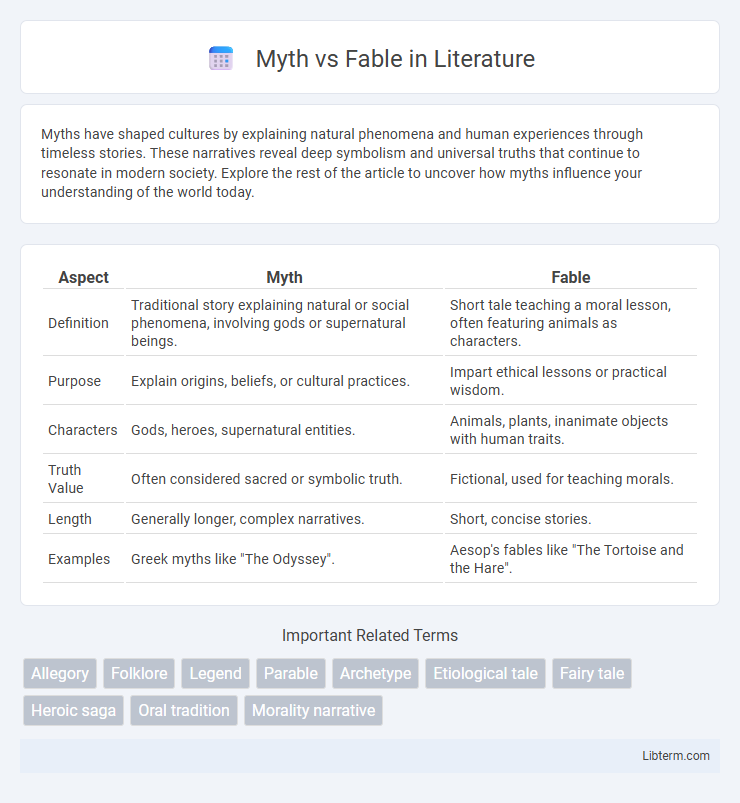Myths have shaped cultures by explaining natural phenomena and human experiences through timeless stories. These narratives reveal deep symbolism and universal truths that continue to resonate in modern society. Explore the rest of the article to uncover how myths influence your understanding of the world today.
Table of Comparison
| Aspect | Myth | Fable |
|---|---|---|
| Definition | Traditional story explaining natural or social phenomena, involving gods or supernatural beings. | Short tale teaching a moral lesson, often featuring animals as characters. |
| Purpose | Explain origins, beliefs, or cultural practices. | Impart ethical lessons or practical wisdom. |
| Characters | Gods, heroes, supernatural entities. | Animals, plants, inanimate objects with human traits. |
| Truth Value | Often considered sacred or symbolic truth. | Fictional, used for teaching morals. |
| Length | Generally longer, complex narratives. | Short, concise stories. |
| Examples | Greek myths like "The Odyssey". | Aesop's fables like "The Tortoise and the Hare". |
Defining Myths and Fables
Myths are traditional stories rooted in ancient cultures, explaining natural phenomena, gods, or the origin of the world, often carrying deep symbolic meanings. Fables are short tales featuring anthropomorphic animals or objects intended to teach moral lessons or ethical principles through simple narratives. Both myths and fables serve educational and cultural purposes but differ in their thematic focus and narrative complexity.
Historical Origins of Myths and Fables
Myths originated in ancient civilizations as sacred stories explaining natural phenomena, human origins, and cultural customs, often involving gods and supernatural beings. Fables emerged later as short, didactic tales featuring anthropomorphic animals designed to impart moral lessons to society. Both genres reflect historical attempts to convey values and understand the world, but myths are rooted in religious tradition while fables are primarily educational narratives.
Core Differences Between Myths and Fables
Myths are traditional stories often involving gods or supernatural beings that explain natural phenomena, cultural practices, or origins, while fables are short narratives typically featuring animals as characters that convey moral lessons. Myths serve to provide a cultural or religious framework, whereas fables emphasize ethical teaching and practical wisdom. The primary distinction lies in myth's emphasis on explaining existence and fables' focus on imparting moral values.
Common Themes in Myths
Myths frequently explore common themes such as creation, the origins of the world, and the battles between gods and humans, reflecting cultural explanations for natural phenomena and human experiences. They often emphasize the struggle between good and evil, fate and free will, and the heroic journey, serving as foundational stories that convey moral values and societal norms. These recurring themes in myths provide insight into the beliefs and worldviews of ancient civilizations.
Common Themes in Fables
Common themes in fables often revolve around morality, teaching lessons about virtues such as honesty, kindness, and cleverness. Characters are typically anthropomorphic animals that symbolize human traits, making the messages easily relatable and memorable. These timeless stories emphasize practical wisdom and ethical behavior through simple, clear narratives.
Role of Morals in Fables
Fables serve a distinct role by embedding clear morals that guide ethical behavior and decision-making, often conveyed through anthropomorphic characters and concise narratives. These stories simplify complex human nature concepts, making moral lessons accessible and memorable for all ages. Unlike myths, which primarily explain natural phenomena or cultural origins, fables prioritize instructive messages that reinforce societal values.
Cultural Impact of Myths
Myths serve as foundational narratives that shape cultural identity and values across societies, often explaining natural phenomena or human behavior through gods, heroes, and symbolic stories. These enduring tales influence religious beliefs, moral codes, and social customs, reinforcing shared worldviews and communal cohesion. Unlike fables, which primarily aim to teach simple moral lessons, myths carry profound cultural significance by connecting past traditions with contemporary cultural practices.
Famous Examples of Myths and Fables
Greek mythology features famous myths such as the tale of Hercules and the Twelve Labors, showcasing heroic feats and divine interactions. Aesop's fables, like "The Tortoise and the Hare" and "The Fox and the Grapes," illustrate moral lessons through anthropomorphic animals. Both genres use storytelling to convey cultural values, but myths often explain natural phenomena or origins, while fables emphasize ethical teachings.
Myths and Fables in Modern Storytelling
Myths often explore universal themes and archetypes rooted in ancient cultures, providing foundational narratives that shape modern storytelling's structure and symbolism. Fables use concise narratives with moral lessons and anthropomorphic characters, influencing contemporary children's literature and educational media. Together, myths and fables enrich modern stories by blending timeless values with accessible formats that resonate across generations.
Why Understanding the Distinction Matters
Understanding the distinction between myths and fables clarifies their cultural and educational roles, as myths often explain natural phenomena and convey religious beliefs, while fables teach moral lessons through animal characters. This differentiation helps educators select appropriate stories for teaching critical thinking and ethical values in various contexts. Recognizing these differences enhances literary analysis and preserves the unique heritage embedded in each storytelling tradition.
Myth Infographic

 libterm.com
libterm.com